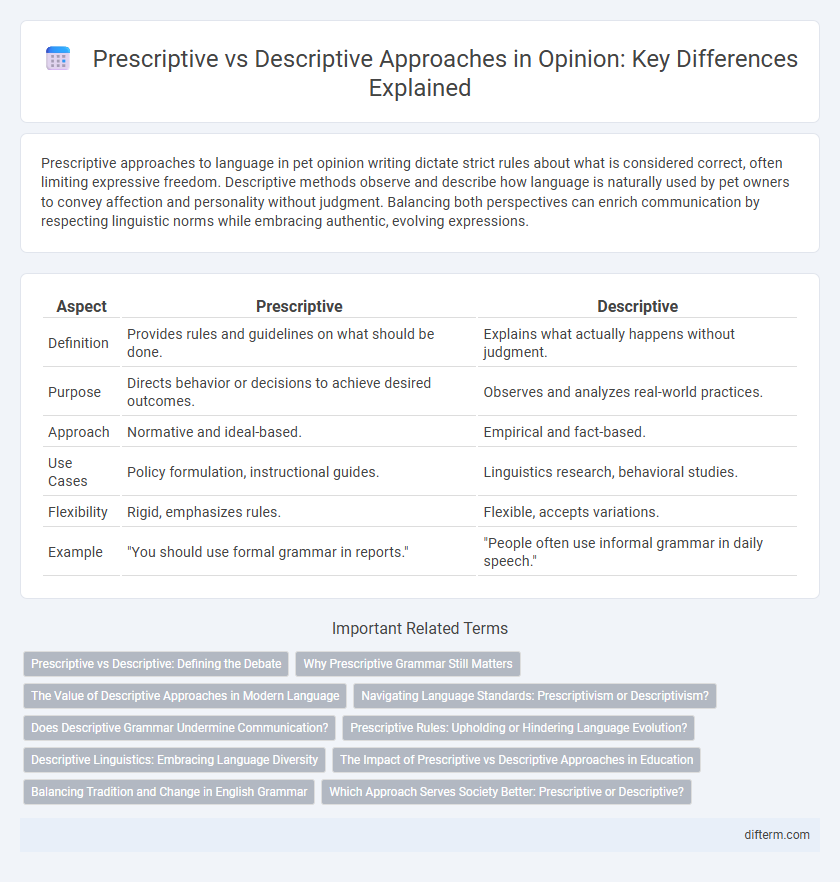Prescriptive approaches to language in pet opinion writing dictate strict rules about what is considered correct, often limiting expressive freedom. Descriptive methods observe and describe how language is naturally used by pet owners to convey affection and personality without judgment. Balancing both perspectives can enrich communication by respecting linguistic norms while embracing authentic, evolving expressions.
Table of Comparison
| Aspect | Prescriptive | Descriptive |
|---|---|---|
| Definition | Provides rules and guidelines on what should be done. | Explains what actually happens without judgment. |
| Purpose | Directs behavior or decisions to achieve desired outcomes. | Observes and analyzes real-world practices. |
| Approach | Normative and ideal-based. | Empirical and fact-based. |
| Use Cases | Policy formulation, instructional guides. | Linguistics research, behavioral studies. |
| Flexibility | Rigid, emphasizes rules. | Flexible, accepts variations. |
| Example | "You should use formal grammar in reports." | "People often use informal grammar in daily speech." |
Prescriptive vs Descriptive: Defining the Debate
Prescriptive approaches establish rules and standards dictating how language should be used, emphasizing correctness and formal norms. Descriptive perspectives observe and document actual language usage without judgment, highlighting natural evolution and diversity. The debate centers on whether language should be governed by strict guidelines or understood through real-world practice.
Why Prescriptive Grammar Still Matters
Prescriptive grammar provides clear rules that ensure effective communication and maintain linguistic standards, which is crucial for formal writing and professional settings. Understanding prescriptive norms helps prevent ambiguity and fosters consistency across different English dialects. While descriptive grammar describes language as it is used, prescriptive rules guide learners in mastering the language for clarity and precision.
The Value of Descriptive Approaches in Modern Language
Descriptive approaches to language provide a valuable framework for understanding how people actually use language in everyday contexts, capturing the rich diversity of dialects, slang, and evolving grammar. This method embraces linguistic variation and change, offering insights into communication patterns that prescriptive rules often overlook or suppress. Emphasizing descriptive linguistics enhances language education and technology development by aligning with authentic usage rather than rigid norms.
Navigating Language Standards: Prescriptivism or Descriptivism?
Prescriptive grammar insists on strict rules and traditional standards to maintain clarity and consistency in language use, which can support effective communication and educational frameworks. Descriptive grammar, on the other hand, embraces linguistic diversity by documenting how language is actually spoken and written, reflecting evolving cultural and social contexts. Balancing prescriptivism with descriptivism allows for a dynamic understanding of language that adapts to usage trends while preserving essential norms.
Does Descriptive Grammar Undermine Communication?
Descriptive grammar reflects actual language use, capturing the evolving patterns that facilitate natural communication among speakers. Prescriptive grammar, while providing clear structural rules, can sometimes hinder authentic expression by imposing rigid standards that do not account for linguistic diversity. Embracing descriptive grammar enhances mutual understanding by acknowledging the dynamic and context-dependent nature of communication.
Prescriptive Rules: Upholding or Hindering Language Evolution?
Prescriptive rules in language serve to uphold standardized grammar and usage, ensuring clarity and mutual understanding across diverse communication contexts. However, rigid adherence to these rules can hinder natural language evolution, stifling creativity and the organic development of slang, dialects, and new expressions. Balancing prescriptive norms with descriptive flexibility allows language to maintain coherence while adapting to cultural and technological changes.
Descriptive Linguistics: Embracing Language Diversity
Descriptive linguistics analyzes language as it is naturally used, capturing the rich diversity of dialects, slang, and evolving grammar across cultures. Embracing this approach fosters inclusivity and reflects the dynamic nature of communication in real-world contexts. Recognizing language variety enhances understanding and respects the identities of diverse speech communities.
The Impact of Prescriptive vs Descriptive Approaches in Education
Prescriptive approaches in education establish clear standards and structured curricula that guide student learning outcomes and ensure consistent knowledge acquisition. Descriptive methods emphasize observing and understanding students' natural learning processes, fostering adaptability and personalized instruction. Balancing these approaches impacts educational effectiveness by combining standardized goals with responsiveness to diverse learner needs.
Balancing Tradition and Change in English Grammar
Balancing tradition and change in English grammar requires recognizing the value of prescriptive rules that maintain clarity and coherence while embracing descriptive observations of evolving language use. Prescriptive grammar provides standardized guidelines essential for formal communication, whereas descriptive grammar captures the dynamic, living reality of how English speakers adapt and innovate. Achieving harmony between these approaches encourages linguistic flexibility without sacrificing structural integrity.
Which Approach Serves Society Better: Prescriptive or Descriptive?
Prescriptive language guides societal norms by establishing clear rules and standards, fostering consistency and mutual understanding essential for social cohesion. Descriptive language, reflecting natural usage and evolving communication, promotes inclusivity and adaptability, capturing the dynamic nature of society. Balancing prescriptive clarity with descriptive flexibility ensures effective communication and cultural growth within diverse communities.
prescriptive vs descriptive Infographic

 difterm.com
difterm.com